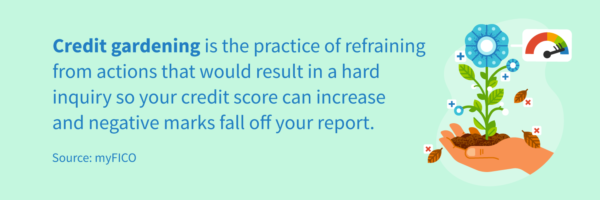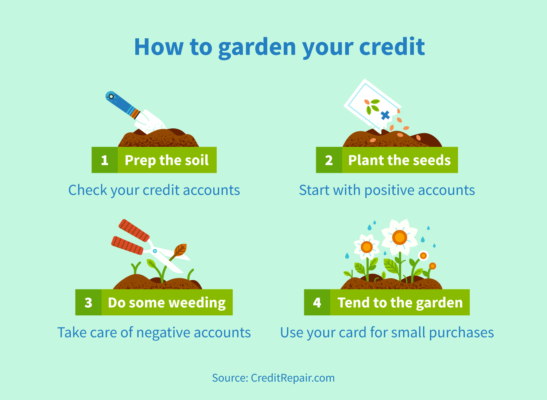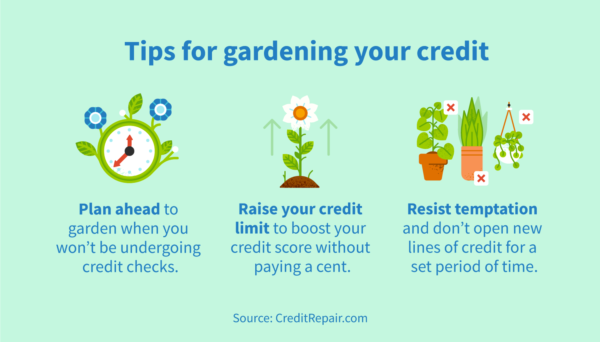
Disclosure regarding our editorial content standards
Much like a houseplant or garden, your credit requires consistent care and attention. Essentially, that’s what the term “credit gardening” means—the practice of caring for your credit and not getting any hard inquiries, so you can grow new lines of credit while shedding negative marks on your credit report.
This includes checking your report frequently and paying your credit card bill on time to ensure your credit score goes up and negative credit statements go down. If you’re curious about how to cultivate better credit, read on for tips anyone can use.
Credit gardening is a practice that anyone who wants a better credit score and options for future lines of credit can adopt. This makes you a more appealing candidate for lenders and improves your chances of being accepted for credit cards with higher limits.

Much like actual gardening, perfecting the steps of credit gardening takes time and practice. Don’t be afraid to try a few different methods until you find what works best for you and your situation.
1. Prep the soil: check your credit accounts
You don’t need gloves, soil or seeds to do some prep work—just your credit card statements and credit reports (which you can request for free once per year from each of the three credit bureaus). Luckily, anyone can do this, whether you have a nearly perfect score or need to put in a little work to get the score you want.
2. Plant the seeds: start with positive, open accounts
Once your credit has been checked, it’s time to plant the “seeds” that will help you work toward better credit. A good credit mix will typically have between two and three lines of credit, from loans to credit cards. Ensuring ahead of time that you have positive accounts that meet these standards will make the credit gardening process much smoother.

3. Do some weeding: see if any accounts need to be taken care of
Once you’ve determined that your existing accounts are in a good place, you should see what negative items could be impacting your score, such as delinquent accounts or late payments.
It can feel like the end of the world when something impacts your credit in a big way, but it’s important to wait it out — or if needed, taking the necessary steps to dispute your credit report if a negative mark was reported in error. Through on-time payments and no hard inquiries, your score could bounce back in a big way.
4. Tend to the garden: use your card for small purchases
You can’t ignore a credit account and expect it to improve, just like you can’t ignore a plant and expect it to bloom. Tend to your credit by using your card for small purchases like a grocery run or filling up your gas tank a few times a month.
This ensures that your accounts aren’t being ignored and can continue to have a positive effect on your credit. Be sure to pay your monthly balance in full so you don’t have to worry about dreaded interest accruing.
How long should you garden your credit?
Though how long you should garden your credit depends on your exact circumstances, FICO® recommends two timelines. First, you can set a time-bound goal for yourself that requires an improved credit score, like applying for a mortgage in five months.
If you don’t have something specific you’re working toward but want to garden your credit regardless, a rough timeline of six months should do the trick.
How to cultivate better credit
Whether you want to qualify for a new credit card or improve your credit as a whole, here are some tips to ensure your gardening goes smoothly.
Plan ahead
Avoid anything that could bring your score down while gardening credit, such as credit checks for a new apartment or mortgage. This makes it important to plan ahead so you can avoid a credit inquiry tanking the score you’ve worked so hard to nurture.
Try: Gardening your credit when you don’t plan on opening any loans or applying for new forms of credit.
Raise your limits
Raising the limit on your credit card is an easy way to give your score a boost by improving your credit utilization ratio. If you have multiple credit cards, investigate a higher limit with the card issuer you have the best relationship (and credit history) with, as this request won’t always be accepted if lenders decide you’re not a great candidate.
Try: Negotiating with a credit card lender you have an established relationship with to increase your credit limit.

Resist the temptation
If you find yourself tempted by shiny new cards with great travel rewards or hefty signing bonuses, you may want to say no until you’re done credit gardening. Opening new lines of credit will cause your score to go down, so remind yourself it will be worth it when you have better credit.
Try: Unsubscribing from credit card and loan offers or newsletters until you’re finished credit gardening.
Though you can’t go into a garden and pluck out perfect credit scores or credit cards with no limit, you can apply some healthy credit habits. Through careful cultivation and work, you can grow new lines of credit and get rid of bad scores to ensure a better financial future for yourself.






